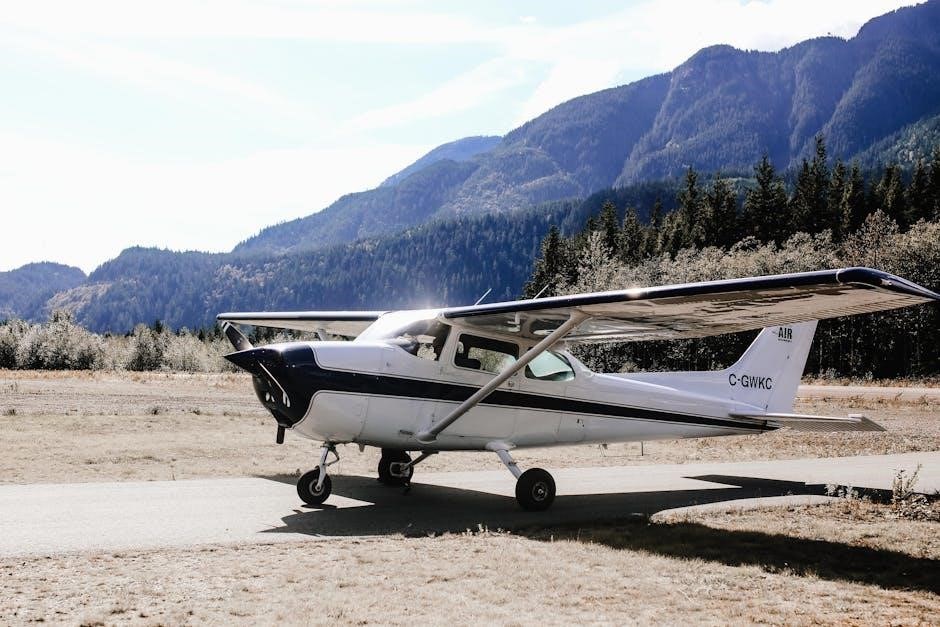
The Cessna 172 Service Manual is an essential guide for maintaining the aircraft’s airworthiness. It provides detailed instructions for inspections‚ troubleshooting‚ and repairs‚ ensuring compliance with safety standards. This manual is crucial for owners‚ mechanics‚ and pilots to ensure optimal performance and safety.
Overview of the Cessna 172 Aircraft
The Cessna 172 is a widely recognized single-engine‚ high-wing aircraft manufactured by Cessna Aircraft Company. Known for its reliability and versatility‚ it is one of the most popular general aviation aircraft globally. Designed for four seats‚ the 172 is constructed with an all-metal‚ semi-monocoque fuselage‚ ensuring durability and strength. Its robust design makes it an ideal trainer for flight schools and a trusted choice for private pilots. The aircraft features a fixed tricycle landing gear‚ a 180-horsepower Lycoming IO-360-L2A engine‚ and a maximum cruising speed of approximately 140 knots. With a fuel capacity of 53 gallons‚ the 172 offers a range of around 800 nautical miles‚ making it suitable for both short and long-distance flights; Its simplicity‚ stability‚ and forgiving flight characteristics have made the Cessna 172 a cornerstone of aviation training and personal flying for decades.
Importance of the Service Manual for Maintenance
The Cessna 172 Service Manual is indispensable for ensuring the aircraft’s safety‚ reliability‚ and performance. It provides comprehensive guidelines for routine inspections‚ repairs‚ and replacements‚ helping maintenance personnel adhere to manufacturer specifications. By following the manual‚ technicians can identify potential issues early‚ preventing costly repairs and enhancing flight safety. The manual also serves as a reference for troubleshooting common problems‚ such as oil and fuel leaks‚ electrical system malfunctions‚ and wear on critical components like hoses and fittings. Regular adherence to the service manual’s schedules‚ such as the 50-hour and 100-hour inspections‚ ensures compliance with aviation regulations and maintains the aircraft’s airworthiness. Ultimately‚ the service manual is a vital tool for preserving the integrity of the Cessna 172‚ making it a must-have for anyone involved in its maintenance and operation.
Structure and Organization of the Service Manual
The Cessna 172 Service Manual is meticulously organized to facilitate efficient access to critical maintenance information. It begins with an introduction detailing the aircraft’s specifications and the manual’s purpose. The document is divided into logical sections‚ each addressing specific systems and components‚ such as the fuselage‚ wings‚ engine‚ fuel‚ hydraulic‚ and electrical systems. Maintenance procedures are categorized by frequency‚ including pre-flight‚ post-flight‚ 50-hour‚ and 100-hour inspections‚ ensuring a systematic approach to upkeep. The manual also includes detailed troubleshooting guides for electrical and avionics systems‚ as well as instructions for replacing hoses‚ lines‚ and fittings. Tables‚ diagrams‚ and checklists are prominently featured to simplify complex tasks. Additionally‚ the manual incorporates supplementary materials‚ such as compliance notes and vendor publications‚ to ensure adherence to safety and regulatory standards. This structured format allows maintenance personnel to quickly locate and apply the necessary procedures‚ ensuring the Cessna 172 remains airworthy and performs optimally.

Aircraft Systems and Components

The Cessna 172 Service Manual covers detailed procedures for inspecting and maintaining aircraft systems‚ including the fuselage‚ wings‚ engine‚ propeller‚ fuel‚ hydraulic‚ electrical‚ and avionics. It ensures comprehensive maintenance of all critical components.

Fuselage and Wing Inspection Procedures
The Cessna 172 Service Manual outlines detailed procedures for inspecting the fuselage and wings to ensure structural integrity and safety. Visual inspections are required to identify any damage‚ dents‚ or corrosion on the skin and underlying structures. Specific attention is given to attachment points‚ rivets‚ and seams. Wing spar inspection is critical‚ focusing on cracks or signs of stress. Control surfaces‚ such as flaps and ailerons‚ must be checked for proper alignment and functionality. The manual recommends using magnifying glasses and specialized tools for thorough examination. Any defects found must be documented and addressed promptly. Regular intervals‚ such as every 50 and 100 hours of operation‚ are specified for these checks. Additionally‚ torque testing of bolts and fasteners ensures proper securing of components. The manual emphasizes the importance of maintaining accurate records of inspections and repairs for compliance with aviation standards.
Engine and Propeller Maintenance Guidelines
The Cessna 172 Service Manual provides comprehensive guidelines for engine and propeller maintenance to ensure optimal performance and safety. Regular inspections of the engine compartment are required‚ focusing on oil and fuel leaks‚ hose condition‚ and intake/exhaust system integrity. The manual specifies checks for engine mounts‚ cooling systems‚ and cylinder compression. Propeller maintenance includes visual inspections for nicks‚ cracks‚ and corrosion‚ as well as balancing and torque checks on propeller bolts. Lubrication schedules are outlined‚ emphasizing the use of approved oils and greases. Every 50 hours‚ engine components like hoses and lines must be inspected‚ while more detailed checks are required at 100-hour intervals. Additionally‚ the manual includes procedures for propeller pitch adjustments and blade repairs. Adhering to these guidelines ensures the engine and propeller remain in airworthy condition‚ maintaining the aircraft’s reliability and efficiency. Proper documentation of all maintenance activities is also stressed to comply with aviation regulations.
Fuel and Hydraulic Systems Service Instructions
The Cessna 172 Service Manual outlines detailed procedures for maintaining the fuel and hydraulic systems to ensure safe and efficient operation. Regular inspections of fuel tanks‚ lines‚ and fittings are required to detect leaks‚ corrosion‚ or damage. The manual specifies cleaning procedures for fuel system components and recommends periodic pressure testing to identify potential issues. Fuel filters must be replaced at prescribed intervals to prevent contamination and maintain proper fuel flow. For the hydraulic system‚ which primarily supports the landing gear and flaps‚ the manual provides guidelines for fluid level checks‚ system bleeding‚ and inspection of hydraulic lines and actuators. Maintenance tasks include checking brake system functionality and ensuring all components comply with aviation standards. Proper servicing of these systems is critical to prevent failures and ensure reliable aircraft performance. Adherence to the manual’s instructions guarantees the fuel and hydraulic systems operate efficiently and safely‚ maintaining the aircraft’s airworthiness. Regular maintenance schedules are emphasized to avoid unexpected malfunctions during flight operations.
Electrical and Avionics Systems Troubleshooting
The Cessna 172 Service Manual provides comprehensive guidelines for diagnosing and resolving issues within the electrical and avionics systems. Troubleshooting begins with identifying symptoms such as faulty instrument readings‚ power fluctuations‚ or communication system malfunctions. The manual recommends checking circuit breakers‚ wiring connections‚ and battery condition to isolate the root cause. For avionics‚ specific attention is given to navigation‚ communication‚ and flight control systems. Detailed step-by-step procedures outline how to test components like GPS units‚ transponders‚ and altimeters. Maintenance tasks include inspecting connectors for corrosion‚ verifying proper system grounding‚ and ensuring all avionics software is up-to-date. Regular checks of the electrical system‚ such as voltage levels and amperage draw‚ are essential to prevent failures. The manual emphasizes the importance of adhering to these procedures to ensure reliable operation of critical flight systems. Proper troubleshooting and maintenance are vital for maintaining aircraft safety and performance‚ especially during flight operations. Adherence to these guidelines ensures the electrical and avionics systems function as intended‚ supporting safe and efficient flight operations.

Maintenance Procedures and Schedules
The Cessna 172 Service Manual outlines detailed maintenance procedures and schedules to ensure aircraft airworthiness. It includes pre-flight and post-flight checklists‚ 50-hour and 100-hour inspections‚ and guidelines for oil and fuel leak detection. Regular schedules ensure safety and efficiency.
Pre-Flight and Post-Flight Inspection Checklists
The Cessna 172 Service Manual provides comprehensive pre-flight and post-flight inspection checklists to ensure the aircraft’s safety and readiness for operation. These checklists are divided into visual inspections and functional tests‚ covering critical systems such as control surfaces‚ tires‚ brakes‚ and landing gear. The pre-flight inspection includes checking for structural damage‚ proper tire inflation‚ and secure fasteners. The post-flight inspection focuses on identifying potential issues like oil or fuel leaks‚ worn components‚ and proper system functionality. Additionally‚ the manual emphasizes the importance of documenting findings and addressing any anomalies promptly. These detailed procedures help maintain the aircraft’s airworthiness and prevent operational hazards. By following these checklists‚ pilots and maintenance personnel can ensure the Cessna 172 operates safely and efficiently.
50-Hour and 100-Hour Inspection Requirements
The Cessna 172 Service Manual outlines specific inspection requirements at 50-hour and 100-hour intervals to ensure the aircraft’s continued airworthiness. The 50-hour inspection focuses on critical systems‚ including oil and filter changes‚ spark plug cleaning‚ and fuel system checks. It also requires inspecting hoses‚ lines‚ and fittings for signs of wear or leaks. The 100-hour inspection is more comprehensive‚ covering control surfaces‚ landing gear‚ and electrical systems. Additionally‚ it includes detailed checks of the engine compartment‚ intake and exhaust systems‚ and propeller condition. These inspections must be documented and comply with FAA regulations. The manual provides detailed procedures for each task‚ ensuring that all components are thoroughly evaluated and maintained. Regular adherence to these schedules helps prevent potential issues and ensures the aircraft remains safe and operational. Proper documentation of these inspections is also emphasized for compliance and maintenance tracking.
Oil and Fuel Leak Detection Methods
The Cessna 172 Service Manual provides detailed procedures for detecting oil and fuel leaks‚ which are critical for maintaining aircraft safety and performance. Visual inspections are emphasized‚ focusing on hoses‚ lines‚ and fittings for signs of deterioration or seepage. The manual recommends cleaning the engine and compartment before inspection to ensure accurate leak detection. Pressure testing is another method‚ particularly for fuel lines‚ to identify leaks under operational stress. Additionally‚ dye tests can be used to trace elusive leaks‚ especially in fuel systems‚ by introducing a fluorescent dye that becomes visible under UV light. These methods ensure early detection of potential issues‚ preventing costly repairs and ensuring compliance with safety standards. Proper documentation of all inspections and repairs is also highlighted to maintain traceability and compliance with maintenance requirements. Regular leak checks are integral to the overall maintenance routine‚ ensuring the aircraft remains airworthy and reliable.
Replacement of Hoses‚ Lines‚ and Fittings
The Cessna 172 Service Manual outlines specific procedures for replacing hoses‚ lines‚ and fittings to ensure aircraft safety and performance. Before starting‚ the manual recommends draining fuel and disconnecting the battery to prevent accidents. Each hose and line must be inspected for signs of wear‚ cracks‚ or corrosion‚ with particular attention to high-stress areas. When replacing‚ only approved materials and components should be used to maintain compatibility and durability. Fittings and connectors must be tightened to the torque specifications provided in the manual to avoid leaks or damage. After installation‚ a thorough pressure test is required to verify system integrity. Additionally‚ the manual emphasizes proper documentation of all replacements‚ including part numbers and dates‚ to maintain compliance with maintenance records. Regular replacement of these components is critical to preventing failures and ensuring the aircraft remains airworthy. Adhering to these guidelines helps maintain the reliability and safety of the Cessna 172.